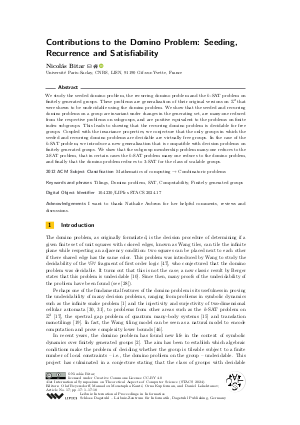@InProceedings{bitar:LIPIcs.STACS.2024.17,
author = {Bitar, Nicol\'{a}s},
title = {{Contributions to the Domino Problem: Seeding, Recurrence and Satisfiability}},
booktitle = {41st International Symposium on Theoretical Aspects of Computer Science (STACS 2024)},
pages = {17:1--17:18},
series = {Leibniz International Proceedings in Informatics (LIPIcs)},
ISBN = {978-3-95977-311-9},
ISSN = {1868-8969},
year = {2024},
volume = {289},
editor = {Beyersdorff, Olaf and Kant\'{e}, Mamadou Moustapha and Kupferman, Orna and Lokshtanov, Daniel},
publisher = {Schloss Dagstuhl -- Leibniz-Zentrum f{\"u}r Informatik},
address = {Dagstuhl, Germany},
URL = {https://drops.dagstuhl.de/entities/document/10.4230/LIPIcs.STACS.2024.17},
URN = {urn:nbn:de:0030-drops-197275},
doi = {10.4230/LIPIcs.STACS.2024.17},
annote = {Keywords: Tilings, Domino problem, SAT, Computability, Finitely generated groups}
}

 Creative Commons Attribution 4.0 International license
Creative Commons Attribution 4.0 International license






















